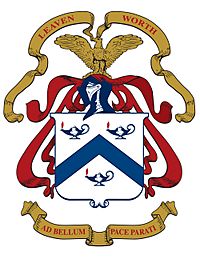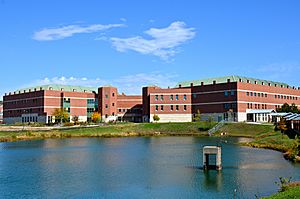United States Army Command and General Staff College facts for kids
Quick facts for kids The Command and General Staff College |
|
|---|---|

Fort Leavenworth, U.S. Army Combined Arms Center, and U.S. Army Command and General Staff College Device
|
|
| Active | 1881–present |
| Country | |
| Branch | |
| Garrison/HQ | Fort Leavenworth, Kansas |
| Motto(s) | Ad Bellum Pace Parati |
| Commanders | |
| Commandant | LTG Theodore D. Martin |
| Deputy Commandant | MG Donn H. Hill |
The United States Army Command and General Staff College (CGSC) is a special school for military officers in the United States Army and other armed forces. It's located at Fort Leavenworth, Kansas. Officers from other countries also attend this school.
It was started in 1881 by William Tecumseh Sherman. Back then, it was called the School of Application for Infantry and Cavalry. It helped train officers for foot soldiers (infantry) and horse soldiers (cavalry). Over the years, its name changed, and its lessons grew to include what was learned from big wars like World War I and World War II. The school keeps changing its lessons to include new information from today's conflicts.
Besides its main campus, the college has smaller campuses in other states like Virginia, Georgia, and Alabama. The college also offers online classes for some of its programs.
Contents
What the College Does
The United States Army Command and General Staff College (CGSC) helps train and develop military leaders. These leaders learn how to work in different types of operations, including those with other countries and government groups. The college also helps improve how the Army trains its leaders. It works to advance the skills and knowledge needed for military jobs.
Schools at CGSC

The college has four main schools, each focusing on different types of training for officers:
- Command and General Staff School (CGSS) is for officers from the U.S. Army, other U.S. military branches, and international officers. This program, called Intermediate Level Education (ILE), lasts ten months. Students learn about leadership, military history, and how to plan military operations. About 1,200 U.S. and international officers attend each year. Many students can also earn a Master of Military Arts and Sciences (M.M.A.S.) degree by writing a research paper. This program is approved by the Higher Learning Commission. Officers usually attend CGSS when they are mid-career, getting ready to lead a battalion or work in important staff roles. CGSS also has smaller campuses in other states, where students complete a shorter, 90-day program.
- School of Advanced Military Studies (SAMS) offers advanced lessons on complex military problems. Students who finish this program also earn a Master of Military Arts and Sciences degree. They then become high-level military planners.
- School for Command Preparation (SCP) trains colonels and lieutenant colonels who are chosen to lead brigades or battalions. These courses usually last three to four weeks. They focus on special topics that new commanders need to know.
- School of Advanced Leadership and Tactics (SALT) helps officers continue to learn and grow. It focuses on making officers skilled in their specific military jobs. It also teaches them how to lead and manage teams in battalions and brigades.
During World War I, the CGSC at Fort Leavenworth was closed from 1916 to 1920. Most of its staff went to France to open and run the Army General Staff College there. This was needed to quickly train more command and staff officers for the growing number of Army units.
Master of Military Art and Science Degree
The Command and General Staff College offers a Master of Military Art and Science degree. This degree is given to students who graduate from the School of Advanced Military Studies. It's also given to students from the Command and General Staff School who complete a special research paper. This degree is officially recognized by the Higher Learning Commission.
Military art and science is a field of study that combines many different subjects. It looks at how various fields relate to war, peace, and using military forces. These fields include history, psychology, politics, and economics. It also includes other professional areas like medicine and law, when they relate to the military. This degree helps military professionals think deeply about their work.
- Military Art focuses on the human side of war and military operations. It looks at things like leadership, how people behave, culture, and solving problems. History helps us understand military art better. It also includes military topics like strategy and tactics.
- Military Science focuses on the technical side of war and military operations. It includes things like military technology, engineering, logistics (getting supplies), and communication. Math is a very important tool in military science. Examples include how guns work and how to protect soldiers with new materials.
You can think of military art and science as a "big umbrella." It covers many other school subjects and professional fields.
Famous People Who Attended or Taught Here
Many important people have studied or taught at the Command and General Staff College.
Famous Graduates
|
|
|
|
Famous International Graduates
More than 7,000 international students from 155 countries have attended CGSC since 1894. The college reports that over half of these international graduates become generals in their home countries.
- General Carlos Prats of Chile
- Minister of State General Mohammed F Abo Sak of Saudi Arabia
- Prime Minister and General Kriangsak Chamanan of Thailand
- General Alfredo M. Santos of the Philippines
- Lieutenant General Rafael Ileto of the Philippines
- Prime Minister and General Tran Thien Khiem of South Vietnam
- General Do Cao Tri of South Vietnam
- General Hau Pei-tsun of the Republic of China (Taiwan)
- President Paul Kagame of Rwanda
- General Katumba Wamala of Uganda
- Brigadier General Muhoozi Kainerugaba of Uganda
- General Muhammad Zia-ul-Haq of Pakistan
- General Rahimuddin Khan of Pakistan
- General Jehangir Karamat of Pakistan
- General Ashfaq Parvez Kayani of Pakistan
- General Eiji Kimizuka of Japan
- General Hisham Jaber of Lebanon
- General Krishnaswamy Sundarji of Indian Army
- Prime Minister and Brigadier-General Lee Hsien Loong of Singapore
- General Dieudonné Kayembe Mbandakulu of the Democratic Republic of the Congo
- President Gaafar Nimeiry of Sudan
- Lt. Colonel Anastasio Somoza Portocarrero of Nicaragua
- General Nguyễn Hợp Đoàn of South Vietnam
- General Nguyễn Khánh of South Vietnam
- General Phạm Văn Đồng of South Vietnam
- Ministry/Chief of Army General Staff and General Ahmad Yani of Indonesia
- President and General Susilo Bambang Yudhoyono of Indonesia
- General Veljko Kadijević of Yugoslavia
- General Antonio Domingo Bussi of Argentina
- General Moeen U Ahmed of Bangladesh
- General Amer Khammash of Jordan
- General Arne Dagfin Dahl of Norway
- General Gustav Hägglund of Finland
- General Avigdor Kahalani of Israel
- Lieutenant General David Tevzadze of Georgia
- Major General Vladimer Chachibaia of Georgia
- Colonel Nikoloz Janjgava of Georgia
- General Moeen U Ahmed of Bangladesh
- Général d'armée René Imbot of France
- King Hamad bin Isa Al Khalifa of Bahrain
- General Abdulkadir Sheikh Dini of Somalia
- Colonel Ahmed Mohammed Ali of Egypt
- Lieutenant General Sean McCann of Ireland
- General Mahesh Senanayake of Sri Lanka
- General Bipin Rawat of India
- Lieutenant General Mykhailo Zabrodskyi of Ukraine
Notable Faculty and Deputy Commandants
These are some of the important people who have taught or held leadership roles at the college:
- Robert Arter (Deputy Commandant 1977–79)
- Richard E. Cavazos (faculty 1970–71)
- Roger H.C. Donlon (1978–81)
- Frederick M. Franks Jr. (Deputy commandant 1985–87)
- Glenn K. Otis Deputy Chief of Staff 1976–78
- Colin Powell Deputy Commanding General (1982–83)
- Gordon R. Sullivan Deputy Commandant 1987–88
- Adna R. Chaffee Jr. 1919–20
- Clarence R. Huebner (1929–33)
- Walter Krueger (1901–12)
- Lucian Truscott 1934–40
Commandants
Since 1976, the leader of the college, called the commandant, has been a lieutenant general. David Petraeus was the commandant from 2005 to 2007. After that, he went on to lead the Multi-National Force in Iraq.
Images for kids




